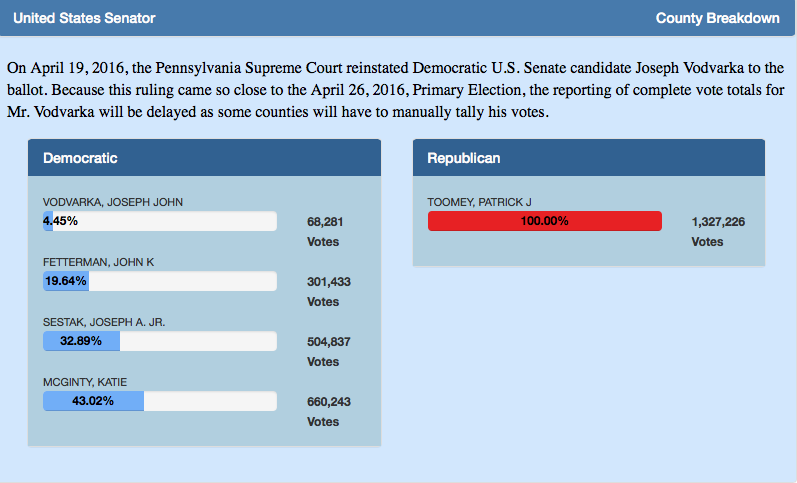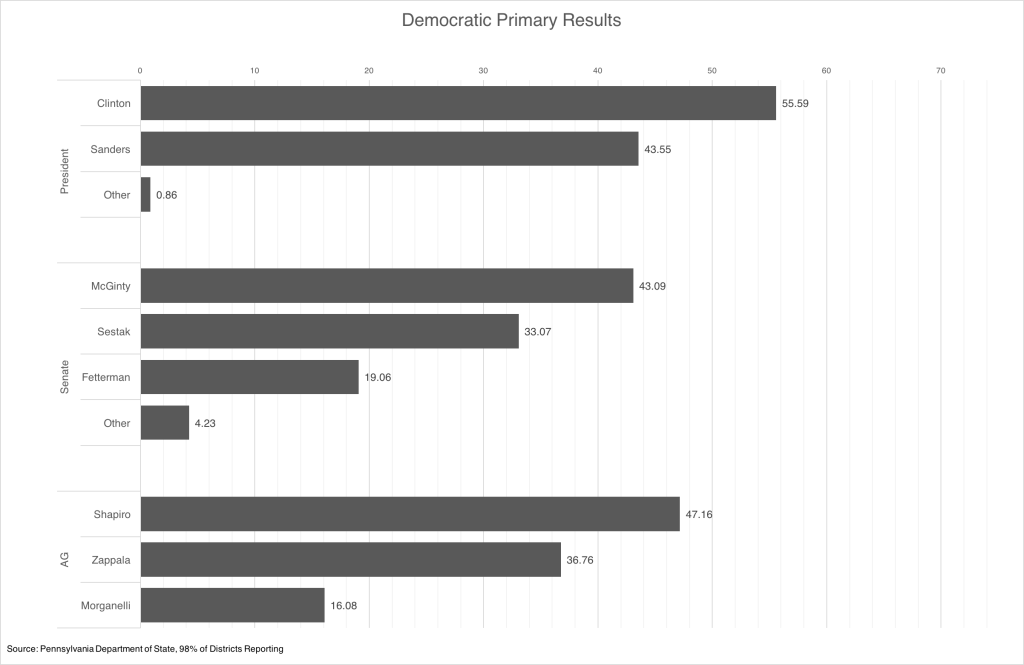Nicholas Pyeatt | assistant professor of political science at Penn State Altoona
Last Tuesday’s Pennsylvania Primary has come and gone, so here’s a follow up to a few of the “what to watch” highlights I previewed.
Clinton and Expectations: The overall results for Clinton were excellent. She won the state by roughly 12 percentage points and over 200,000 votes out of 1.6 million cast. More importantly, she was able to meet her expectations for the election margin and was able to win many more counties than expected. While some of her best counties were the urban ones (for example a 2 to 1 margin in Philadelphia County), she was able to win all of the suburban southeastern Pennsylvania counties, most of the counties around Pittsburgh and a number of rural counties as well.
In other words, not only did Clinton win big in the primary, but she won all in all the counties she will need to win the state in November. In 2012, Obama won the state by roughly 300,000 votes carrying only 13 of the state’s 67 counties: Erie, Allegheny, Centre, Dauphin, Luzerne, Lackawanna, Monroe, Northampton, Lehigh, Bucks, Montgomery, Philadelphia and Delaware. This past Tuesday, Clinton won every one of those counties except for Centre County and won a number of additional counties as well. All in all, Clinton may have effectively ended the primary with this decisive win in Pennsylvania.
Trump and Momentum: As good as Pennsylvania was to Clinton last week, it was even better for Trump. While he continues to struggle with the more organizationally heavy primary tasks like state conventions, when it comes to winning Republican primaries, Trump has excelled. Last Tuesday, nationally he won all five states and all but one (Maryland) with more than 55 percent of the vote. In Pennsylvania, Trump was dominant, winning every single county and most of them with more than 50 percent of the vote. While the state’s large number of unpledged delegates may have muted his victory somewhat, his dominant performance gives him real momentum.
The Wolf Effect: While most of the national focus, quite rightly, was on the presidential primary, one of the most interesting elections last week was the primary for Senate on the Democratic side. Democrats are especially optimistic about their chances of flipping the upper chamber. To do so, they will have to pick a majority of freshman senators from 2010 such as Pennsylvania’s Pat Toomey. While Toomey has made some efforts to differentiate himself from other Republicans in Congress (such as his gun control efforts), the freshman senator still has somewhat uphill odds given the Democratic tilt of the state.
The race to challenge Toomey got off to an incredibly quick start with 2010 challenger and former Rep. Joe Sestak announcing his repeat candidacy very early in Toomey’s term. Sestak, who has never gotten along well with the party leadership, received two challengers: one in Katie McGinty, Tom Wolf’s former chief of staff, and Braddock Mayor John Fetterman. The party apparatus went hard for McGinty; she received endorsements from the governor, Sen. Casey, Senate Majority Leader Harry Reid and the Democratic Senatorial Campaign Committee (who also spent at least $400,000 on ads). In the end, the party’s efforts were not in vain as McGinty won, and relatively easily. She received roughly 150,000 more votes than Sestak and might have received even more had Fetterman not outperformed expectations by receiving almost 20 percent of the vote and winning Allegheny County. While Sestak did the best in some of the southeastern Pennsylvania counties around Philadelphia, those margins were nowhere near large enough to overcome McGivney’s convincing victory across the rest of the state. Now that the Governor and the Democratic Party have the candidate they want, the question remains: Can she defeat Toomey?
The Tea Party and Congress: With Clinton, Trump and McGinty winning by fairly large margins, one of the last races of the night to be called was the one for Representative of the Ninth District. This large district, covering parts of twelve counties in the southwestern and southcentral parts of the state, has been held by Rep. Shuster since 2001. Shuster, who is chairman of the House Transportation Committee and connected to the leadership, faced a tough challenge in 2014 from Art Halvorson and Travis Schooley. Expecting a repeat challenge from Halvorson, Shuster was prepared for another primary race this year. The election was a competitive one, and throughout the night it was unclear who would prevail.
In the end, Shuster scraped out a victory, winning by roughly one thousand votes out of more than 90,000 cast. While the margin was narrow, perhaps the most worrying part of the evening for Shuster was the fact that he lost both Blair County (his home county) and Fulton County, the two biggest counties in the district. While the incumbent has likely held on for one more term as the general election is unlikely to be competitive, the results from this race definitely lead this observer to wonder about where this leaves the incumbent for the future.








